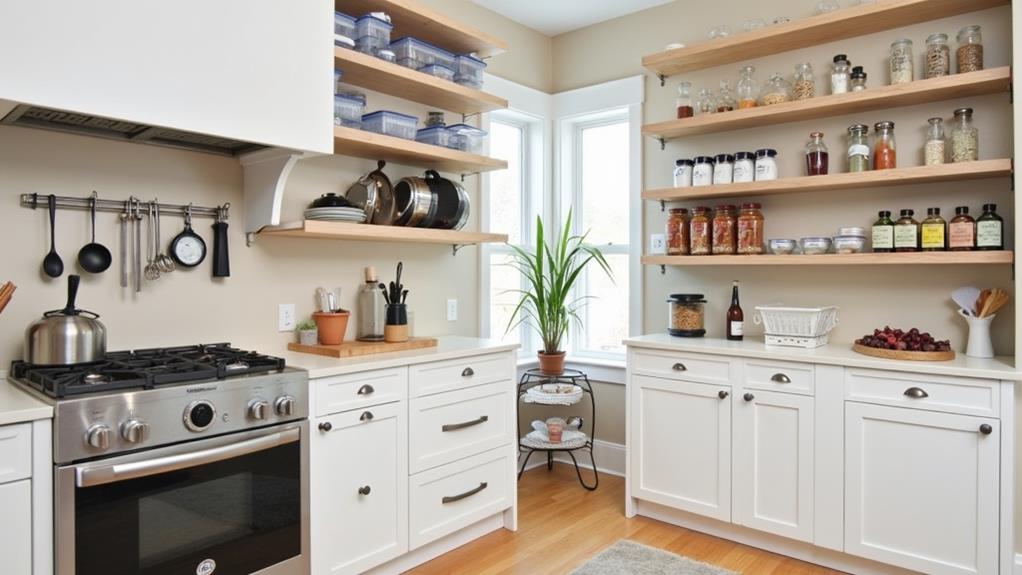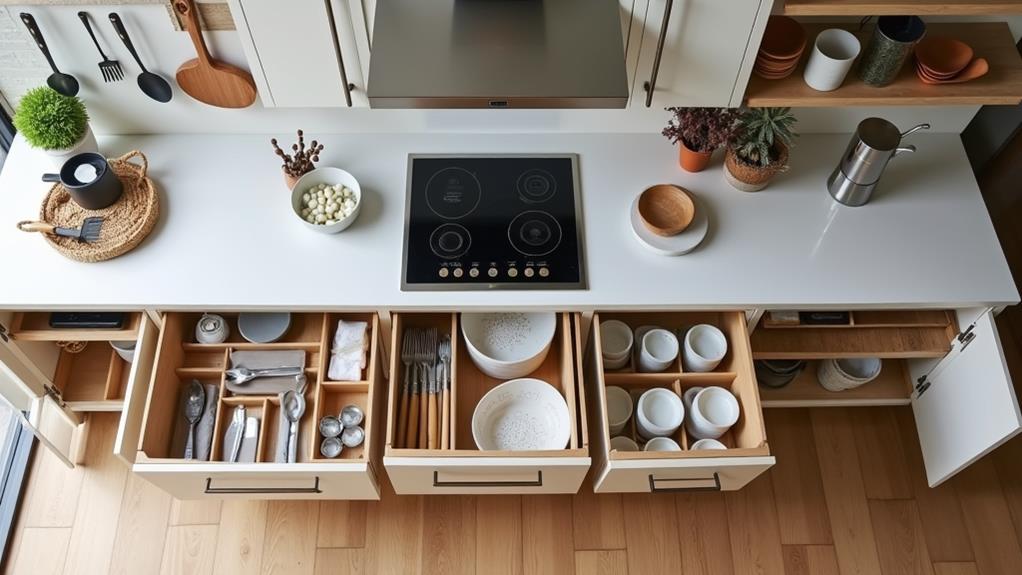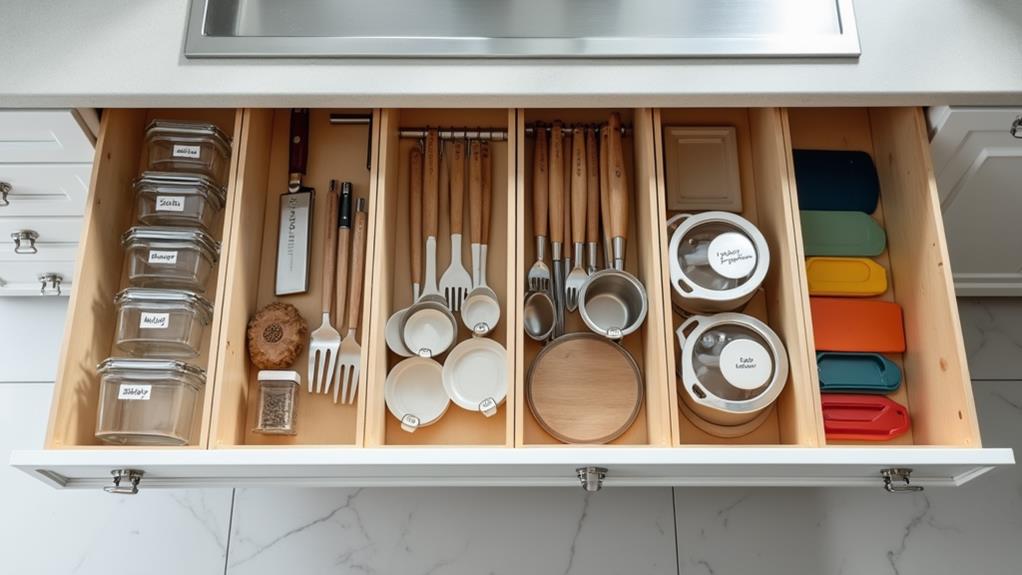Ready to conquer kitchen chaos? Start by evaluating your current layout—what's working and what's not? Next, define functional zones for cooking, cleaning, and prep. You'll love how this streamlines your workflow! Now, optimize storage solutions. Think vertical shelves and pull-out drawers—game changers! Don't forget to streamline traffic flow; keep that work triangle tight, mama! Finally, implement your changes and be open to adjustments. Remember, organizing is an ongoing process, just like motherhood. Isn't it amazing how a well-organized kitchen can make you feel like a superhero? But wait, there's more to discover about transforming your culinary command center!
Quick Takeaways
- Assess your current layout by evaluating task frequency and measuring available space.
- Define functional zones for cooking, cleaning, and food preparation.
- Optimize storage with vertical solutions and pull-out shelves to maximize space efficiency.
- Streamline traffic flow by maintaining clear pathways and applying the work triangle concept.
- Implement changes gradually and adjust organization strategies as needed over time.
Assess Your Current Layout
The foundation of an efficient kitchen lies in understanding your current layout. To assess your current layout, start by evaluating how often you perform different tasks. This'll help you identify high-traffic areas that need better organization. Measure your space to figure out what storage solutions might work best. Consider wall-mounted options like floating shelves or rail hanger racks to maximize vertical space and keep essential items within reach. And don't forget to observe which items you use most frequently – it's key for creating zones that make sense for you!
Take a good look at those problem zones, too. Are your countertops always cluttered? Can't reach that one pesky cabinet? Jot it all down. Remember the work triangle concept – you want your stove, sink, and fridge to play nice together. By optimizing your workflow, you'll save time and energy. Who doesn't want that? A well-organized kitchen is a happy kitchen, and trust me, it'll make your life so much easier
Define Functional Zones
When it comes to defining functional zones, think of your kitchen as a well-oiled machine. You'll want to organize your kitchen cabinets and storage space to help keep similar items together. Create a cooking zone near the stove, a cleaning zone by the sink, and a prep area for chopping veggies. Consider adding versatile organizers that can accommodate various kitchen items, from towels to utensils, maximizing your space efficiency. Trust me, this will boost your efficiency during meal preparation like you wouldn't believe!
Here are three key benefits of functional zones:
- Less running around like a headless chicken
- Easier to find what you need in a pinch
- More time to actually enjoy cooking (and maybe a glass of wine!)
Remember to keep frequently used items close at hand. It's all about making your life easier, mama! By organizing your kitchen this way, you'll feel like a culinary superhero in no time
Optimize Storage Solutions

Often overlooked, storage solutions can make or break your kitchen's functionality. But don't worry, mama! You've got this. Start by going vertical – shelves, hooks, and wall-mounted racks are your new best friends. They'll free up precious counter space and keep your kitchen clutter-free. Remember those frustrating deep cabinets? Pull-out shelves are here to save the day! No more playing hide-and-seek with your pots and pans. Consider investing in stackable storage drawers to maximize vertical space and improve visibility of your items. These organizers often feature clear designs and sliding rails for easy access.
And let's talk pantry organization. Clear, labeled containers are a game-changer. You'll feel like a superhero when you can grab that elusive bag of flour in seconds. Tiered organizers and Lazy Susans? They're not just for fancy kitchens anymore. They'll transform your cabinets into storage powerhouses. But here's the real secret: declutter regularly. It's like giving your kitchen a mini-makeover every time
Streamline Traffic Flow
Now that you've mastered storage solutions, let's focus on the heart of kitchen functionality: traffic flow. You'll want to organize your kitchen layout to streamline movement and boost efficiency. Create clear pathways by maintaining at least 42 inches between counters and islands. This space guarantees smooth traffic flow, even when the whole family's pitching in! Consider incorporating custom pull-out drawers to maximize cabinet space and improve accessibility, further enhancing your kitchen's efficiency.
To further optimize your kitchen's flow:
- Implement the work triangle concept, positioning your stove, sink, and fridge within 4-9 feet of each other.
- Store frequently used items near cooking areas, reducing unnecessary steps.
- Create designated spaces for different kitchen zones, like prep and cleaning areas.
Implement and Adjust

The implementation phase is where your kitchen layout plans come to life. As you make changes, remember that organizing your kitchen is an ongoing process. You'll need to stay flexible and adjust as you go. Start by tackling your cabinet and kitchen drawers, implementing new storage options to help keep items you access frequently within reach. Don't be afraid to get creative with design and DIY solutions!
But here's the thing: the entire kitchen won't magically stay organized forever. You'll need to reassess regularly. Are those new drawer dividers working for you? Is that spice rack really saving space? Keep an eye on how your family uses the kitchen and be ready to tweak your layout. Remember, a well-organized kitchen is like a well-oiled machine – it takes maintenance, but it's so worth it!
Common Questions
How Do I Decide Where to Put Things in My Kitchen?
You'll want to position frequently used items near their point of use. Place pots and pans close to the stove, and store dishes near the dishwasher. Create functional zones and utilize vertical storage to maximize space and efficiency.
What Are the 10 Steps for Organizing Kitchen Cabinets?
Don't panic! It's not as intimidating as it seems. Empty cabinets, sort items, declutter, clean, use organizers, group similar items, position frequently used items accessibly, label containers, maximize vertical space, and maintain organization regularly. You'll have a tidy kitchen in no time!
Where to Put Things in Kitchen Drawers?
You'll want to put frequently used utensils in top drawers at eye level. Use dividers to separate items like spatulas and knives. Consider a tiered system for silverware. Don't forget a designated "junk drawer" for miscellaneous items.
Where Should Plates and Cups Go in a Kitchen?
You'll want to place plates and cups in a cabinet near the dishwasher. Store larger plates on the bottom shelf, with smaller ones above. Keep mugs close to your coffee maker. Use shelf risers to maximize space and visibility.




